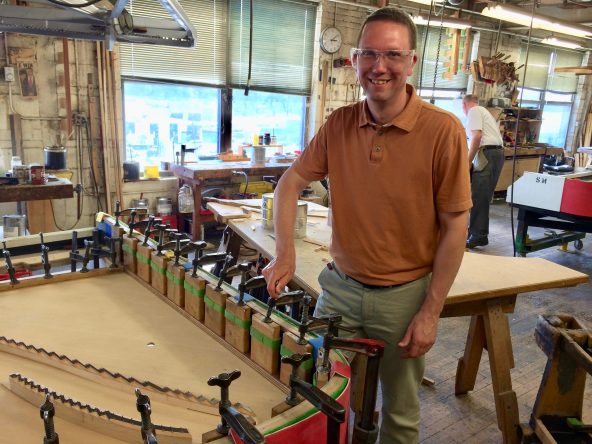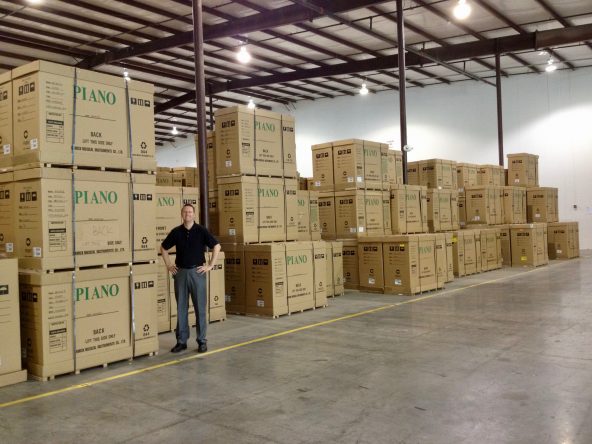“Are any pianos built in the United States?” is asked at least once a day in most piano stores.

Grant helping out at the Steinway factory in Queens, New York
There was a time when there were literally hundreds of domestic piano builders – lead by Steinway & Sons in New York. This era lasted well over 100 years.
In the 1960’s, Yamaha and Kawai in Japan sought to introduce the piano to Asia and find ways to build pianos cheaper. These efforts likely had a greater influence in reported declines in piano sales over the past half century than most people realize. Once the hallmark of quality engineering and construction, these newer pianos built far away using methods that focused on cost savings instead of quality… perhaps they just proved to be uninspiring to new students.
And while companies at the time like Steinway and Baldwin remained focused on quality, new builders from Eastern European countries like Estonia, Bohemia, and the Czech Republic began building pianos to export to the United States. While stores that sold them enjoyed humongous profit margins, customers were again left to wonder why these new pianos did not remind them of the rich sounding, long lasting pianos of the past.
Are we in the new era of American piano domination?
During this “smoke and mirrors” time, a few established brands doubled-down on American craftsmanship and engineering with spectacular results, leading to a quiet resurgence of building and designing pianos in the United States that continues today.
Steinway & Sons took the lead on this phenomenon in the late 1980’s with the ground-up designed Boston piano. What would later be known as the most successful introduction of a piano brand in the 20th century, Boston was a revolutionary approach to piano building for the legendary piano company. It would be the first time they would design a piano to meet a price point. The goal – build the world’s best production piano – something as close as possible to the famed Steinway & Sons… but for half the price.
By 1992, they had met the challenge and then set their sights on bringing the price point lower without compromising quality, sound, or touch. Handing the reigns to Susan Kenagy, she created instruments ‘every bit as good as the higher end Yamaha models’ that had been steadily going up in price for a fraction of the Japanese models. These lower tension design instruments also offered a more “musical” sound quality, with longer sustain and without the “brightness” associated with Asian built pianos. The perfect piano for home players and the best production piano in the price category.
Today, Essex pianos enjoy a loyal following from beginners and professional players, as well as many institutional users who demand the durability that has become synonymous with Steinway & Sons.
Leading by example
Following this example, the piano builder Samick made a substantial investment when they moved their US headquarters to Gallatin, Tennessee… and built a piano factory there. Today, the facility is used as a finishing facility – they call it “deluxing” – for their pianos built in Asia, allowing skilled US craftsmen to put the finishing touches on these instruments before shipping them to dealers and eventually consumers.

Grant at Samick factory in Gallatin Tennessee
The power of advertising
In my opinion, it is admirable that builders like Steinway & Sons and Samick have decided to invest in quality over advertising. While rumors of other companies giving away pianos to artists in exchange for endorsement or paying hundreds of thousands of dollars to have their pianos placed in TV shows, movies, and the like, the question as to “why wouldn’t they just build better pianos?” appears quite simple. They want to sell the sizzle instead of the steak, leaving many piano owners and players unsated.

The light of hope
Yes, quality pianos are still designed and built in our country – and at prices that range from beginner to expert. It is just that, like many things American, one has to look past the wrapping (advertising, fake reviews, product placements) and focus on the substance to find them.
Pianos like Steinway & Sons, Boston, Essex, and the Samick models deluxe at the Tennessee facility continue to inspire players of all levels. It is fair to say that, as good as their pianos have been in the past, the best pianos they build are being built today as they continue to innovate and improve quality and performance.
First conceived in Italy, the piano was perfected in America and remains a truly American instrument. In an age where more and more builders are trying to find ways to build cheaper instruments, it is refreshing to know that there are companies – foreign and domestic – who still believe in delivering quality pianos that are truly American.